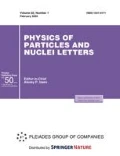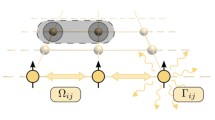Abstract
We study statistical properties of 3D classical spin-glass under the influence of external fields. It is proved that in the framework of the nearest-neighboring model 3D spin-glass problem at performing of Birkhoff’s ergodic hypothesis regarding to orientations of spins in the 3D space can be reduced to the problem of disordered 1D spatial spin-chains (SSC) ensemble where each spin-chain interacts with a random environment. The 1D SSC is defined as a periodic 1D lattice, where spins in nodes are randomly oriented in 3D space, in addition they all interact with each other randomly. For minimization of the Hamiltonian in an arbitrary node of the 1D lattice lattice, we obtained recurrent equations and corresponding Sylvester criterion, which allow to find energy local minimum. On the bases of these equations the high-performance parallel algorithm is developed which allows to calculate all statistical parameters of 3D spin glass, including distribution of a constant of spin-spin interaction, from the first principles of the classical mechanics.
Similar content being viewed by others
References
K. Binder and A. P. Young, “Spin glasses: experimental facts, theoretical concepts and open questions,” Rev. Mod. Phys. 58, 801–976 (1986).
G. Parisi and M. A. Virasoro, Spin Glass Theory and Beyond (World Scientific, Singapore, 1987).
Spin Glasses and Random Fields, Ed. by A. P. Young (World Scientific, Singapore, 1998).
R. Fisch and A. B. Harris, “Spin-glass model in continuous dimensionality,” Phys. Rev. Lett. 47, 620 (1981).
C. Ancona-Torres, D. M. Silevitch, G. Aeppli, and T. F. Rosenbaum, “Quantum and classical glass transitions in LiHoxY1-XF4,” Phys. Rev. Lett. 101, 057201 (2008).
A. Bovier, Statistical Mechanics of Disordered Systems: A Mathematical Perspective, Cambridge Series in Statistical and Probabilistic Mathematics (Cambridge, 2006), p. 308.
Y. Tu, J. Tersoff, and G. Grinstein, “Properties of a continuous-random-network model for amorphous systems,” Phys. Rev. Lett. 81, 4899–4902 (1998).
K. V. R. Chary and G. Govil, NMR in Biological Systems: From Molecules to Human (Springer, 2008), p. 511.
E. Baake, M. Baake, and H. Wagner, “Ising quantum chain is a equivalent to a aodel of biological evolution,” Phys. Rev. Lett. 78, 559–562 (1997).
I. Giardina, Random Fields and Spin Glasses: A Field Theory Approach (Cambridge Univ. Press, Cambridge, 2006), p. 230.
P. Contucci and C. Giardina, Perspectives on Spin Glasses (Cambridge Univ. Press, Cambridge, 2012), p. 217.
D. Sherrington and S. Kirkpatrick, “A solvable model of a spin-glass,” Phys. Rev. Lett. 35, 1792–1796 (1975).
A. S. Gevorkyan, “Quantum 3D spin-glass system on the scales of space-time periods of external electromagnetic fields,” Phys. At. Nucl. 75, 1253–1265 (2012).
B. Derrida, “Random-energy model: an exactly solvable model of disordered systems,” Phys. Rev. B 24, 2613–2626 (1981).
G. Parisi, “Infinite number of order parameters for spin-glasses,” Phys. Rev. Lett. 43, 1754–1756 (1979).
A. J. Bray and M. A. Moore, “Replica-symmetry breaking in spin-glass theories,” Phys. Rev. Lett. 41, 1068–1072 (1978).
J. F. Fernandez and D. Sherrington, “Randomly located spins with oscillatory interactions,” Phys. Rev. B 18, 6270–6274 (1978).
F. Benamira, J. P. Provost, and G. J. Vallèe, “Separable and non-separable spin glass models,” J. Phys. 46, 1269–1275 (1985).
D. Grensing and R. Kühn, “On classical spin-glass models,” J. Phys. 48, 713–721 (1987).
A. S. Gevorkyan, H. G. Abajyan, and E. A. Ayryan, “On modeling of statistical properties of classical 3D spin glasses,” Bull. PFUR. Ser. Mathem. Inform. Sci. Phys., No. 4, 91–103 (2011).
A. S. Gevorkyan and H. G. Abajyan, “Classical spin glass system in external fields with taking into account relaxation effects,” Phys. At. Nucl. 76, 1015 (2013).
Author information
Authors and Affiliations
Corresponding author
Additional information
The article is published in the original.
Rights and permissions
About this article
Cite this article
Ayryan, E.A., Gevorkyan, A.S. & Sahakyan, V.V. New algorithm for simulation of 3D classical spin glasses under the influence of external electromagnetic fields. Phys. Part. Nuclei Lett. 12, 380–384 (2015). https://doi.org/10.1134/S154747711503005X
Published:
Issue Date:
DOI: https://doi.org/10.1134/S154747711503005X




